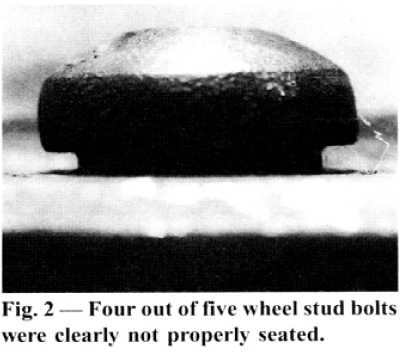Originally Posted By: The Critic
Originally Posted By: Bottom_Feeder
Originally Posted By: GreeCguy
Cut remains of broken stud flush with wheel hub with saw.
Drill out broken stud.
Collapse said stud with chisel and hammer.
Pound out remains of collapsed stud with hammer and punch.
Why did you need to do any of this? A solid smack on the end of the broken stud with a decent-sized hammer should have made all of these steps irrelevant.
+1
I've done a few of these in about 20 minutes. Of course, there may have been more to the story.
Definitely, at least on what I'm now calling "The Van from Hades."
One, I'm a firm believer that an object with bearings shouldn't be "nailed" with a hammer. Hence the reason I drilled out the old one till it was paper thin around the edges and I could collapse what was left and tap it out very gently.
Two, there's a large dust shield behind the hub which has so little clearance that even a broken stud will not clear, (therefore, welcome the saw as you would an old and helpful friend).
Three, Even though there's a little "D" in the dust shield which I assume is there for such events, the new stud will not pass through said "D" and allow new stud to be installed, (I tried, I REALLY tried in many and various positions and configurations. Blue words were used in this process).
Solution involved bending the dust shield out of the way, installing stud and then bending shield back in position.
That sudden moment of clarity came after some REALLY blue words were used. Thankfully, I was alone.
Originally Posted By: Bottom_Feeder
Originally Posted By: GreeCguy
Cut remains of broken stud flush with wheel hub with saw.
Drill out broken stud.
Collapse said stud with chisel and hammer.
Pound out remains of collapsed stud with hammer and punch.
Why did you need to do any of this? A solid smack on the end of the broken stud with a decent-sized hammer should have made all of these steps irrelevant.
+1
I've done a few of these in about 20 minutes. Of course, there may have been more to the story.
Definitely, at least on what I'm now calling "The Van from Hades."
One, I'm a firm believer that an object with bearings shouldn't be "nailed" with a hammer. Hence the reason I drilled out the old one till it was paper thin around the edges and I could collapse what was left and tap it out very gently.
Two, there's a large dust shield behind the hub which has so little clearance that even a broken stud will not clear, (therefore, welcome the saw as you would an old and helpful friend).
Three, Even though there's a little "D" in the dust shield which I assume is there for such events, the new stud will not pass through said "D" and allow new stud to be installed, (I tried, I REALLY tried in many and various positions and configurations. Blue words were used in this process).
Solution involved bending the dust shield out of the way, installing stud and then bending shield back in position.
That sudden moment of clarity came after some REALLY blue words were used. Thankfully, I was alone.

